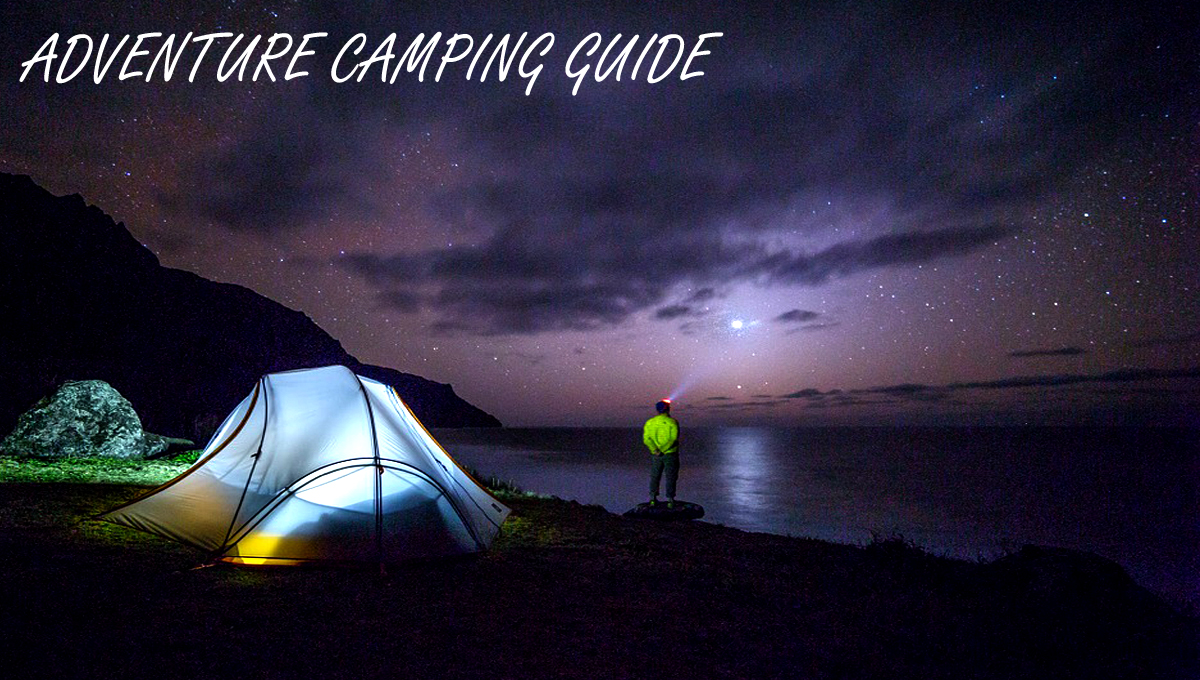WHAT IS ADVENTURE CAMPING?
An adventure camp is a type of recreational program that typically involves outdoor activities such as hiking, camping, rock climbing, canoeing, and other outdoor pursuits. The goal of an adventure camp is to provide a fun and challenging experience for participants while also teaching them new skills and building confidence and self-esteem. Adventure camps can be designed for a variety of age groups and skill levels, and can last for a few days or several weeks.
WHAT ARE THE BENEFITS OF ADVENTURE CAMPING?
Adventure camping can offer a variety of benefits, including:
- Physical fitness: Outdoor activities such as hiking, canoeing, and rock climbing can provide a challenging and intense workout, helping to improve cardiovascular health, muscle strength, and endurance.
- Mental health: Being in nature can have a calming and restorative effect on the mind, helping to reduce stress and improve overall well-being.
- Teamwork and leadership: Adventure camping often requires participants to work together as a team, which can help to build communication and problem-solving skills, as well as leadership abilities.
- Confidence and self-esteem: Taking on new challenges and overcoming obstacles can help to build confidence and self-esteem, which can have a positive impact on other areas of life.
- Appreciation for nature: Spending time in nature can help people appreciate and understand the natural world, which can lead to a greater sense of environmental stewardship.
- Sense of accomplishment: Completing a challenging hike or climb can provide a sense of accomplishment and pride.
- Building memories: Adventure camping can be a great way to create lasting memories with friends and family.
CAMPING ESSENTIALS CHECKLIST
CAMPING TENT
A camping tent is a portable shelter that is designed for outdoor use, typically for camping or backpacking. Tents come in a variety of shapes and sizes, and can be designed for different types of camping, such as backpacking, car camping, and family camping. When choosing a camping tent, there are several factors to consider:
- Capacity: Tents are typically designed to sleep a certain number of people, so choose a tent that is appropriate for the number of people who will be using it.
- Seasonality: Consider the type of camping you will be doing and the expected weather conditions. Three-season tents are suitable for spring, summer, and fall, while four-season tents are designed for winter camping and are sturdier and better insulated.
- Weight and pack size: If you will be carrying your tent on a backpacking trip, weight and pack size will be important factors to consider.
- Ease of setup: Some tents are easier to set up than others, so consider how easy a tent is to set up when making your selection.
- Ventilation: Look for a tent with good ventilation to reduce condensation and keep you comfortable.
- Durability: Choose a tent that is made of high-quality materials and is built to last.
- Price: Tents come in a wide range of prices, so consider how much you are willing to spend.
HOW TO INSULATE A TENT IN CAMPING?
Insulating a tent for winter camping is essential to ensure a comfortable and safe camping experience. One of the best ways to insulate a tent is to use a four-season tent, which is designed to withstand harsh winter conditions and typically has better insulation than three-season tents.
Another way to insulate a tent is to add a footprint, a groundcloth that goes under the tent, this helps to insulate the tent from the cold ground. Sleeping pads are also a great way to provide insulation between you and the ground, and can help to keep you warm at night. A sleeping bag rated for the expected temperature, and a liner to add extra insulation, will also help to keep you warm.
HOW TO STAY WARM IN CAMPING?
Using a hot water bottle filled with hot water before going to bed and placing it in your sleeping bag can help keep your feet warm. Camping cots raise you off the ground, which can help to insulate you from the cold ground. A thermal blanket can be used to insulate the tent walls and ceiling, and can help to keep the tent warm.
Moisture can make the inside of the tent colder, so try to keep the inside of the tent as dry as possible. Some campers use portable heaters to keep the tent warm, but make sure it’s safe and allowed in the camping area. Finally, dress in layers and wear insulated clothing to keep warm. It’s also important to note that proper ventilation is still crucial to avoid condensation and to maintain a healthy air inside the tent.
SLEEPING BAGS & SLEEPING PADS
Sleeping bags and sleeping pads are essential gear for camping, especially for colder weather. Sleeping bags are designed to keep you warm by trapping your body heat, while sleeping pads provide insulation between you and the ground.
Sleeping bags come in a variety of shapes and sizes, and can be designed for different temperatures. It is important to choose a sleeping bag that is rated for the lowest expected temperature you will be camping in. Sleeping bags are typically filled with down or synthetic insulation, and are rated by their temperature rating. Down insulation is lightweight and compressible, but loses its insulating properties when wet. Synthetic insulation is bulkier, but keeps you warm even when wet.
Sleeping pads come in different types, closed cell foam pads, self-inflating pads, and air pads. Closed cell foam pads are the most basic and cheapest option, they are durable and easy to pack but they are not as comfortable as other options. Self-inflating pads are filled with an open-cell foam that automatically expands when the valve is opened, they are more comfortable but bulkier and heavier than closed cell foam pads. Air pads are the most comfortable option, they are lightweight and pack able but they are more expensive than other options.
CAMP STOVE AND FUEL
A camp stove is a portable stove that is designed for outdoor use, typically for camping or backpacking. They come in a variety of types, such as canister stoves, liquid fuel stoves, and wood-burning stoves. The type of stove you choose will depend on the type of camping you will be doing and your personal preferences.
Canister stoves are the most popular and easiest to use. They run on small, portable canisters of fuel that screw onto the stove. These stoves are lightweight and easy to use, but the fuel canisters can be expensive and are not always easy to find in remote areas.
Liquid fuel stoves run on white gas, kerosene, or unleaded gasoline. They are more versatile than canister stoves and can burn a wider range of fuels, but they are generally bulkier and heavier.
Wood-burning stoves are a more eco-friendly option as they burn natural materials found in the camping area. They are also versatile, they can burn twigs, sticks, and small branches as fuel. They tend to be bulkier and heavier than the other types of stoves, but they don’t require you to carry fuel.
HEADLAMPS OR FLASHLIGHTS
Headlamps are worn on the head and have a strap that keeps the light securely in place. They are ideal for activities such as hiking, camping, and climbing, as they leave your hands free to perform other tasks. They come in different models with different features, such as a red light mode, strobe mode, and different levels of brightness.
Flashlights, on the other hand, are handheld devices that provide a light source. They are more versatile and can be used for a variety of tasks, such as searching for lost gear, signaling for help, and general illumination. They are also useful as a backup light source in case the batteries on the headlamp run out. They come in different models and sizes, from small key chain lights to larger, heavy-duty flashlights.
15 ESSENTIAL OF CAMPING FIRST AID KIT
A camping first aid kit is a specialized collection of supplies and equipment for use in providing first aid in a camping or outdoor setting. A camping first aid kit should include the following items:
- Basic first aid supplies: bandages, gauze, adhesive tape, antiseptic wipes, and ointment.
- Blister care: moleskin, blister pads, and bandages.
- Wound care: antiseptic wipes, hydrogen peroxide, and antibiotic ointment.
- Pain relief: ibuprofen, acetaminophen, and aspirin.
- Allergy relief: antihistamines and epinephrine (if prescribed).
- Snake bite kit: includes suction cups, and bandages.
- Tweezers and scissors: for removing splinters and other small foreign objects.
- Safety pins: for securing bandages and clothing.
- A thermometer: for checking fever.
- Instant cold packs: for reducing swelling and pain.
- Sunscreen and insect repellent: to protect the skin from sunburns and insect bites.
- A flashlight and a whistle: for signaling for help in case of an emergency.
- A first aid manual: to guide you on how to use the supplies and give first aid.
- Personal Medications: Make sure you bring any personal medications you may need.
- emergency blanket: a compact, lightweight, and waterproof blanket that can be used for warmth and shelter.
MAPS AND COMPASS
A map is an essential tool for camping, as it allows you to navigate and plan your route. It shows you the topography of the area, including the location of trails, campsites, and other landmarks. A compass is also important, as it helps you orient yourself in relation to the map and navigate in the wilderness. Together, a map and compass can help you safely navigate in the wilderness and ensure that you have a successful camping trip.
WHAT IS DIGITAL COMPASS?
A digital compass is a type of electronic compass that uses sensors, such as a magnetometer, to determine the direction of magnetic north. Digital compasses are often found in smartphones and other mobile devices, and can be used as a navigation tool in conjunction with GPS or mapping applications.
Some digital compasses also display additional information, such as the current heading, altitude, and GPS coordinates. However, it’s worth noting that a digital compass may be affected by electronic interference, such as being near power lines or other electronic devices, so it’s always a good idea to have a traditional compass as a backup.
ANALOG COMPASS
An analog compass is a traditional type of compass that uses a magnetized needle or card to indicate magnetic north. The most basic type of analog compass consists of a magnetized needle suspended in a liquid-filled housing, which is often made of plastic or metal. The housing is usually marked with a rotating bezel or compass card, which is used to take bearings and orient the compass to the map.
Analog compasses are generally considered more reliable than digital compasses, and they do not require batteries or electronic components that could fail. They are also inexpensive and easy to use. Some analog compass have additional features like sighting mechanism, rotating bezel, luminous points or declination adjustment.
KNIFE AND MULTI TOOLS
A knife or a multi-tool can be a useful tool for camping, as it can be used for a variety of tasks such as cutting rope, preparing food, and making kindling for a fire.
A knife is a simple and straightforward tool that can be used for a variety of tasks, such as cutting rope or preparing food. A good camping knife will have a sharp and durable blade, a comfortable handle, and a secure sheath for safe storage.
A multi-tool is a versatile and compact tool that can be used for a variety of tasks. Multi-tools typically include a knife blade, pliers, screwdrivers, and other tools. They are designed to be compact and easy to carry, and they can be a great option for camping as they can take care of many needs with one tool.
FIRE STARTER
A fire starter is an essential tool for camping, as it allows you to make a fire for warmth, cooking, and light. There are several different types of fire starters available, including:
- Matches: Strike-anywhere matches or waterproof matches are a simple and reliable way to start a fire. They are easy to use and can be carried in a waterproof container.
- Fire Striker: A fire striker is a small tool that creates sparks when struck against a hard surface. It is often made of steel and can be used to ignite tinder or other kindling.
- Ferrocerium rod: A ferrocerium rod is a type of fire starter that creates sparks when struck against a rough surface. It is a great option for camping and survival situations, as it is durable, easy to use, and can be used in wet conditions.
- Lighter: A lighter is a convenient and easy-to-use fire starter. They are lightweight and can be refilled with fuel.
- Magnesium Fire Starter: Magnesium fire starters are a tool used to create sparks by striking a piece of magnesium against a rough surface, this can be used to ignite tinder or other kindling.
WHAT IS SCOUT MASTER ?
A Scoutmaster is a leader in the Boy Scouts of America (BSA) organization, responsible for leading a Scout troop, which is a group of Scouts. The Scoutmaster is responsible for the overall direction and guidance of the troop, and works with other adult leaders to provide a safe and effective program for the Scouts.
The Scoutmaster plays a vital role in the development of young scouts, providing guidance, mentorship and leadership, helping them to grow and develop into responsible, self-reliant and community-minded individuals.
WHAT ARE THE RESPONSIBILITIES OF SCOUT MASTER ?
The Scoutmaster’s duties include:
- Providing guidance and mentorship to the Scouts
- Helping the Scouts to achieve their rank advancement and other Scouting awards
- Planning and leading outdoor activities and camping trips
- Recruiting and training adult leaders
- Maintaining records and submitting reports
- Helping the Scouts to live by the Scout Oath and Scout Law
- Ensuring the safety of the Scouts
- Communicating with parents and guardians
Scoutmasters are typically volunteers, who have completed the BSA’s Scoutmaster and Assistant Scoutmaster Leader Specific training. They are also expected to complete Youth Protection training, which is a training on how to recognize and prevent child abuse.



